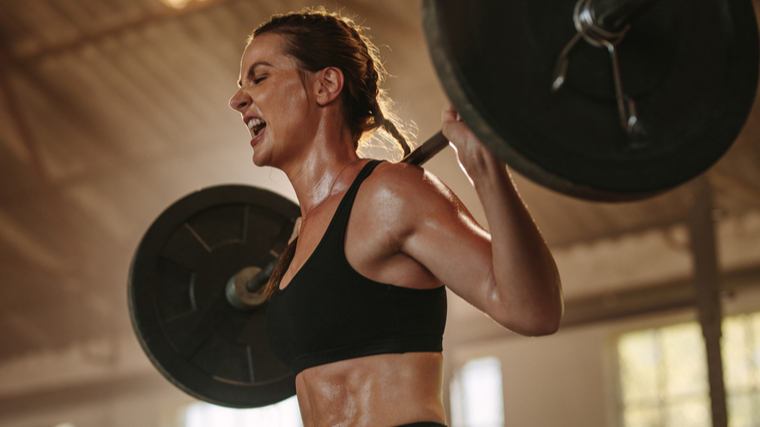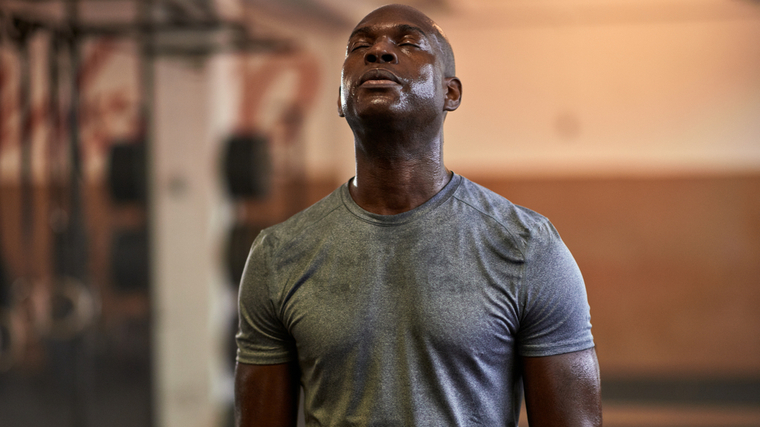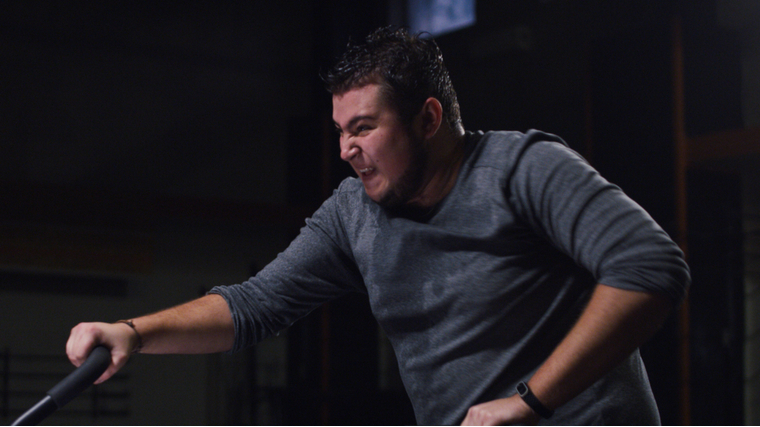Walking out of the workout drenched in sweat might look like the ultimate signal of a fast and furious workout. It’s easy to think that if you don’t have to wring out your gym shirt, you didn’t even try. It might be the opposite of glamorous outside of the gym, but a lot of strength athletes take pride in their sweat sheen inside the gym. It means you’re working hard, right?
Well, sometimes. Some people — no matter how hard they’re going — just don’t sweat as much as others. Maybe you’re one of those sweatless wonders. You’re working your calves off on the treadmill and wondering why the person next to you is looking like Niagra Falls while you’ve barely even got a sheen of sweat.

The good news is, it’s normal for different people to have different rates of sweat — and different areas that sweat tends to pool first. But while sweating very little doesn’t necessarily reflect the quality of your workout, it may be an indicator of something else going on in your body (think: dehydration). There could be a few different reasons why you’re not sweating during your workout, and to optimize your workouts, your recovery, and your overall health, it helps to understand why.
Editor’s note: The content on BarBend is meant to be informative in nature, but it shouldn’t take the place of advice and/or supervision from a medical professional. The opinions and articles on this site are not intended for use as diagnosis, prevention, and/or treatment of health problems. Speak with your physician if you have any concerns.
What is Sweat?
You’ve known this since you started sweating around your crush in sixth grade, but a refresher never hurts. That salty liquid that can leave your armpits soaked, your forehead glistening, and your hands clammy is known as sweat. It’s produced by sweat glands under your skin, and it’s how your body tries to cool itself down so you don’t overheat. Sweat is more than just a reaction during physical activity — you also might get that ambient glow when you’re hot, anxious, or have a fever.
The Science of Sweat
There are three types of sweat glands: eccrine, apocrine, and apoeccrine. You have eccrine sweat glands almost everywhere on your body. These are responsible for producing the most amount of sweat. When your body gets hot, it can start to sweat to help control its temperature — that’s where these glands come in. Eccrine sweat glands secrete water to the surface of your skin, where it’s then evaporated — think about that cold shiver you get when you walk outside after your workout.
Apocrine sweat glands are isolated to certain parts of the body like your armpits, breasts, face, and head. These are the glands that are responsible for body odor but don’t function as such until puberty. Apoeccrine sweat glands are also isolated only to the armpits and start developing around eight to 14 years old. (1)

Sweat itself is almost completely made up of water. But if you’ve seen a sports drink commerical, you know a little something about electrolytes in sweat. Even though you don’t typically need to replace your electrolytes during a workout, sweat does contain small amounts of minerals like sodium, potassium, and calcium, as well as lactate, ammonia, and urea. (2) Yes, sweating helps cool you down, but it can also excrete certain toxins from your body. (3)
When you’re getting your workout on, sweating is normal and can help your body feel good. Your heart, kidney, and skin health may all benefit from consistent sweat sessions. Not only can your physical health improve when you sweat, but your mood and mental health can also get a boost. (4)
Why Do People Sweat During Workouts?
Needing to mop up after yourself when you work out might be a sign that you’re getting after it hard. Or it might be a sign that your gym needs to fix its air conditioning. You might also be sweating up a storm because of individual factors ranging from genetics to your body mass.
Temperature Regulation
When it’s getting hot in here — whether from a workout or nerves — your body might start sweating to regulate your temperature. At rest, your core body temperature generally hovers around 98.6 degrees. But during exercise, it can rise to 100 degrees or more. This is when you may start to feel those sweat beads dripping down your forehead.
Your body isn’t doing this to embarrass you or to make you look extra cool (depending on your perspective regarding sweat stains on your gym shirt). Sweat is an attempt to cool you down to keep you safe. (5) When your body temperature rises high over a normal level, it can result in overheating or hyperthermia. This is when heat stroke or heat exhaustion can occur, which is serious if left untreated. Sweating is meant to help you avoid that.
Individual Differences
The harder you work out, the more heat your body generates. If you’re someone who tends to leak from your armpits and forehead, this can cause you to sweat more. But although the intensity of your workout can affect how much you sweat, that’s not the only factor that plays into it. Your genetics, body mass, environment, and general activity level all affect how much you sweat. It’s not just about your current workout — people who exercise frequently may sweat more and at a faster rate compared to people who don’t. (6)

If you’re concerned about how much sweat you seem to lose — maybe it feels disproportionate to your activity levels, or maybe you have trouble staying hydrated — you might want to check in with a medical professional. A condition known as hyperhidrosis can impact how much you sweat during your workout. Hyperhidrosis is a fancy word for excessive sweating, and about five percent of people may have it. (7)
Why Don’t I Sweat During Workouts?
Although it is natural for a lot of people to soak through their gym shirt and need an excess amount of chalk to keep the barbell in hand, some people barely break a glisten. There are a few different reasons as to why you don’t sweat during your workout.
Dehydration
When your body loses more fluid than it takes in, you can get dehydrated. And that’s not a position an athlete wants to be in. Even just one percent dehydration can affect cognition, and two percent dehydration can affect physical performance. (8)(9) If you don’t drink enough water, it can limit how much your body is able to sweat — instead, it will try to hold onto the water it has. This makes overheating more likely. And if you’ve ever tried to lift heavy while overheated, you know it’s far from pleasant and can even get dangerous. So if you want to sweat a little more, try drinking more water and see if that helps.
Hypohydrosis
Just as people can sweat excessively, others may air on the perpetually dry side. Hypohidrosis refers to the inability to sweat, and it can be dangerous since it diminishes your body’s natural ability to cool itself down. This can be caused by your sweat glands not functioning properly, certain medications, or just straight up genetics. People who have this condition may not even realize or be concerned that they’re not sweating during their workout, so it can sometimes go unnoticed. But try to take note if you never ever need a sweatband, even in intense temperatures, because hypohidrosis can cause heat exhaustion, heat stroke, or even death. (10)
Your Gym’s Environment
If you can leave your workout looking like you spent the whole time on your phone instead of getting after it on the platform, your gym might just have really good temperature control. Regardless of your internal temperature — a potential indicator of how hard you’re working — if the heat balance around you maintains a steady rate, you might not need to sweat as much. (11) If your gym doesn’t overheat when you do, you’re less likely to sweat up a storm. (12) So a well-ventilated, air-conditioned gym might explain your lack of dampness.
Type of Workout
The kind of workout you’re doing might also influence how many shirt changes you’ll need. The length of your rest periods may influence how much you sweat. If you’re doing your workout at a fixed pace — say, steady-state cardio — you’ll sweat differently (possibly more) than if you’re performing a set of five then resting for three to five minutes before your next set. (13) This makes sense to a lot of people who step off the treadmill drenched but leave a session of heavy triples fairly dry. But that doesn’t mean that lifting heavy weights is working less hard than steady-state cardio. They’re just different forms of working out and different kinds of intensity.

Your type of workout might also affect how much you drink — which in turn can impact your sweat levels. Athletes may tend to drink more water than they need during strength training and drink less water than they need during aerobic training. (14) So if you’re sweating less, it doesn’t necessarily mean you’re working less hard — it might just mean you’re training differently and drinking different amounts of water.
Your Fitness Level
Your workout may be extremely intense, but you might also be used to that. If you’re a CrossFitter or endurance athlete who’s accustomed to a specific level of intensity, your body might be accustomed to a certain type of workout — and therefore, you might sweat less than someone running their first 5k or attempting their first WOD. (15)
On the other hand, people who work out a lot are likely to sweat more in general. (6) So it really depends how the sweat cards fall for you. Your workout may be intense, and you may be very physically fit — but the other factors at play (like your gym’s environment and your hydration level) will also impact your degree of sweatiness.
Daily Variation
The rate at which you sweat changes every day. (16) Sure, some people tend to be generally more sweaty than others. But overall, because there are so many factors that go into how much and why you sweat, your daily sweat rate fluctuates. (16) That means that it isn’t necessarily reflective of the quality of your workout if you’re not sweating on any given day — it might just be your body’s regularly-scheduled fluctuations.
Is it Bad Not to Sweat During Workouts?
It might seem like a blessing to walk out of the gym looking the same you did walking in, but not sweating could be a cause for concern. If your gym is a hot box and you just can’t break a solid sweat, you might want to check in with any other symptoms you might have.
If your body’s internal temperature can’t come down, you might find yourself experiencing dizziness, fatigue, or muscle cramps mid-workout. (17) Even outside of your gym sessions, sweating more frequently is associated with improved heart health and skin health. (18)(19) If you find yourself not sweating at all or sweating significantly less than normal, you might want to check in with a doctor just to be sure your body is getting the temperature regulation it needs.
Sweat it Out
Exercise and sweat go hand-in-hand. But you don’t have to sweat as much as the person in the squat rack next to you. Not sweating that much doesn’t necessarily mean you’re not working hard. Understanding why you may not sweat during your workout could be as simple as your day-to-day variations in sweat levels or just be an indicator of your gym’s superior AC system. But to be on the safe side, if your perpetually dry gym shirt is accompanied by dizzy spells or muscle cramps, you might want to go get checked out.
References
- Baker, Lindsay B. Physiology of sweat gland function: The roles of sweating and sweat composition in human health. Temperature Medical Physiology and Beyond. 2019; 6(3).
- Chen, Yi-Lang, Kuan, Wen-Hui, Liu, Chan-Lin. Comparative Study of the Composition of Sweat from Eccrine and Apocrine Sweat Glands during Exercise and in Heat. International Journal of Environmental Research and Public Health. 2020; 17(10).
- Sears, Margaret E. Arsenic, Cadmium, Lead, and Mercury in Sweat: A Systematic Review. 2012.
- Balchin, Ross, Linde, Jani, & Blackhurst, Dee. Sweating away depression? The impact of intensive exercise on depression. Journal of Affective Disorders. 2016.
- Gleeson, M. Temperature Regulation During Exercise. International Journal of Sports Medicine. 1998; 19.
- Lee, Jeong-Beom, Kim, Tae-Wook, & Min, Young-Ki. Long Distance Runners Present Upregulated Sweating Responses than Sedentary Counterparts. PLOSOne. 2014.
- Doolittle, James, Walker, Patricia, & Mills, Thomas. Hyperhidrosis: an update on prevalence and severity in the United States. Archives of Dermatological Research. 2018; 308.
- Lieberman, Harris R. Hydration and cognition: a critical review and recommendations for future research. Journal of the American College of Nutrition. 2007; 26.
- Popkin, Barry M., D’Anci, Kristen E., Rosenberg, Irwin H. Water, Hydration, and Health. Nutrition Review. 2010; 68(8).
- Chia, K Y, Tey, H L. Approach to hypohidrosis. Journal of the European Academy of Dermatology and Venereology. 2013; 27(7).
- Ravanelli N, Imbeault P, Jay O. Steady-state sweating during exercise is determined by the evaporative requirement for heat balance independently of absolute core and skin temperatures. J Physiol. 2020 Jul;598(13):2607-2619.
- Smith JW, Bello ML, Price FG. A Case-Series Observation of Sweat Rate Variability in Endurance-Trained Athletes. Nutrients. 2021 May 26;13(6):1807.
- Foster J, Hodder SG, Lloyd AB, Havenith G. Individual Responses to Heat Stress: Implications for Hyperthermia and Physical Work Capacity. Front Physiol. 2020 Sep 11;11:541483.
- Cosgrove SD, Love TD, Brown RC, Baker DF, Howe AS, Black KE. Fluid and electrolyte balance during two different preseason training sessions in elite rugby union players. J Strength Cond Res. 2014 Feb;28(2):520-7.
- Foster J, Hodder SG, Lloyd AB, Havenith G. Individual Responses to Heat Stress: Implications for Hyperthermia and Physical Work Capacity. Front Physiol. 2020 Sep 11;11:541483.
- Smith JW, Bello ML, Price FG. A Case-Series Observation of Sweat Rate Variability in Endurance-Trained Athletes. Nutrients. 2021 May 26;13(6):1807.
- Sorensen, Matthew D., Chi, Thomas, & Shara, Nawar M. Activity, Energy Intake, Obesity, and the Risk of Incident Kidney Stones in Postmenopausal Women: A Report from the Women’s Health Initiative. J Am Soc Nephrol. 2014; 25(2).
- Laukkanen, Tanjaniina, Khan, Hassan, Zaccardi, Francesco. Association Between Sauna Bathing and Fatal Cardiovascular and All-Cause Mortality Events. JAMA Internal Medicine. 2015; 175(4).
- Hussain, Joy, Cohen, Marc. Clinical Effects of Regular Dry Sauna Bathing: A Systematic Review. Hindawi. 2018.
Featured Image: Rawpixel.com / Shutterstock